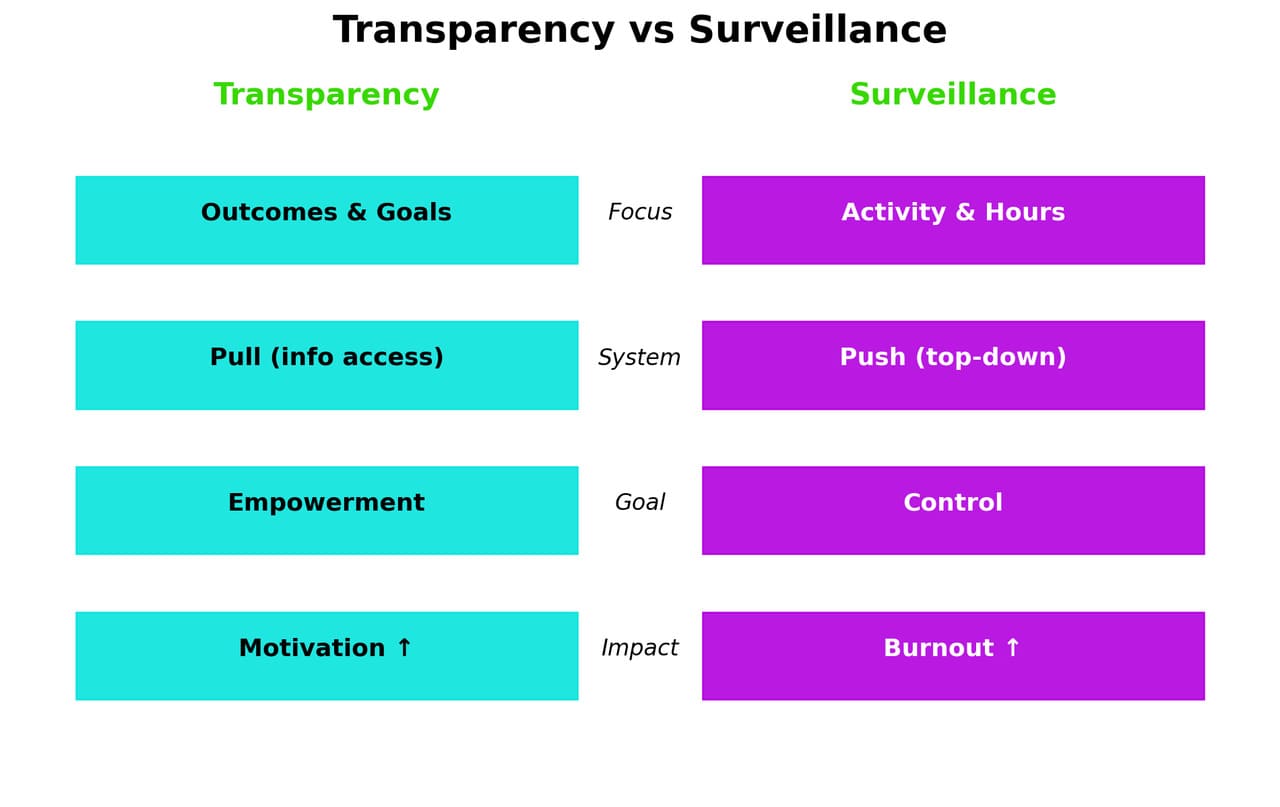Transparency or Surveillance? How the Finnish Model of Trust Wins in the Hybrid World
- Introduction: The Hybrid Leader’s Dilemma
- The Fine Line: When Openness Becomes Control
- The Finnish Context: Why Surveillance is an Insult to Sisu
- Tools for Fear-Free Transparency: A Practical Framework
- Case Study: How a Danish Tech Company Restored Trust
- Conclusion: Your Choice Defines Your Culture
Introduction: The Hybrid Leader’s Dilemma
Every leader of a hybrid team asks themselves the same question: “How can I be sure my team is productive if I can’t see them working?” This question is a fork in the road, leading down two entirely different paths. The first path is surveillance, built on fear and control. The second is transparency, built on trust. In the Finnish and Nordic business culture, where trust is a national asset, the path you choose defines not just your management style, but the future of your company.
The Fine Line: When Openness Becomes Control
It’s crucial to understand the fundamental difference between these two concepts.
- Transparency is about creating a shared environment where goals, progress on tasks, and challenges are visible to everyone involved. It is a “pull system” where every employee can access the information they need to make smart, autonomous decisions. The goal of transparency is empowerment.
- Surveillance is about monitoring employee activity: tracking keystrokes, taking screenshots, or analyzing time spent “online.” It is a “push system” imposed from the top down to enforce compliance. The goal of surveillance is control.

Research, including reports from Gartner, shows that digital surveillance directly leads to lower motivation, burnout, and a paradoxical drop in productivity. When employees feel they are not trusted, they spend their energy not on productive work, but on performing productivity.
The Finnish Context: Why Surveillance is an Insult to Sisu
In Finland, a high-trust society is not just a cultural feature; it is a proven competitive advantage. We are used to relying on each other’s word and sense of responsibility. Implementing surveillance systems in such an environment creates cultural dissonance. It is a direct statement to employees that says, “We do not trust you.”
This approach insults the very essence of the Finnish concept of Sisu. Sisu is more than just perseverance through hardship. It is an inner resilience, self-discipline, and reliability that enables Finns to do their work well without external control. Micromanagement and surveillance destroy this intrinsic motivation, replacing it with a fear of punishment.
Tools for Fear-Free Transparency: A Practical Framework
How can you achieve the visibility you need without destroying trust? The answer lies in shifting the focus from controlling people to creating transparent processes.
- Focus on Outcomes, Not Activity. Instead of counting hours, measure progress against clear, mutually agreed-upon goals. Frameworks like OKRs (Objectives and Key Results) are excellent for this, making everyone’s contribution visible and measurable.
- Make the Work Visible, Not the Worker. Use modern project management tools (like Jira, Asana, or Trello) where the status of any task is available to the entire team. This builds horizontal accountability and eliminates the need for constant “status update” requests.
- Create a Rhythm of Communication. Regular, predictable rituals—like short daily stand-ups or weekly written updates—create a sense of transparency and alignment without the need for constant interruptions.
But how do you make visible the contributions that happen “between the tasks”—helping a colleague, mentoring, or showing initiative? This is where theory needs practical tools. Modern technology can automate and scale these processes. For example, platforms like AlbiCoins are designed for this exact purpose.
Instead of tracking activity, they enable valuable actions to be made visible through a system of peer-to-peer recognition. Employees can instantly thank each other by sending a digital internal currency (“AlbiCoins”) for specific help, an innovative idea, or behavior that reflects company values. This shifts the focus from “Are you working?” to “What value are you creating?”. This approach motivates rather than controls, making positive contributions visible and rewarded.
Case Study: How a Danish Tech Company Restored Trust
After transitioning to a hybrid model, a Danish IT company experienced a drop in morale after implementing employee activity monitoring software. Noticing a rise in “quiet quitting,” the HR Director initiated the removal of the system. In its place, the company introduced a transparent OKR framework and a platform for peer-to-peer recognition. As a result, within six months, employee engagement (measured by eNPS surveys) increased by 15%, and managers reported spending significantly less time on monitoring and more on strategic tasks and coaching their teams.
Conclusion: Your Choice Defines Your Culture
Visibility achieved through surveillance destroys trust, autonomy, and ultimately, your business. Visibility built on transparency strengthens them. The choice you make as a leader directly shapes your company’s culture and its ability to attract and retain talent in the modern world.
Start with one simple step: in your next team meeting, have an open discussion about what “healthy transparency” means to all of you, and choose one tool or ritual that will help you achieve it together, without control.
References:
- The Potentials and Pitfalls of Algorithmic Management at the Workplace
A report from ETLA Economic Research in Finland discussing the dual nature of workplace technology, including its potential for both efficiency and intrusive control. - An article from a UK-based HR publication detailing the rise of surveillance technologies and their impact on employee relations and trust.
A report from ETLA Economic Research in Finland discussing the dual nature of workplace technology, including its potential for both efficiency and intrusive control. - The dynamics of trust and control in a Danish post-bureaucratic organization
An academic paper from the Journal of Business Ethics that explores the delicate balance between trust and control mechanisms, with a case study from a Danish organization. - Employee monitoring and surveillance: The rising challenge for employers
A publication from Eurofound (European Foundation for the Improvement of Living and Working Conditions) that provides a Europe-wide perspective on the legal and ethical challenges of workplace monitoring. - Trust in the workplace: A new evidence-based approach
An article from the BI Norwegian Business School’s research review, outlining practical, evidence-based strategies for building and maintaining trust within organizations..


